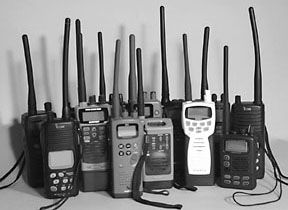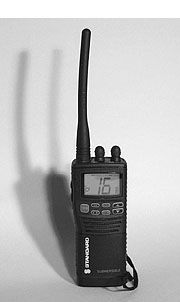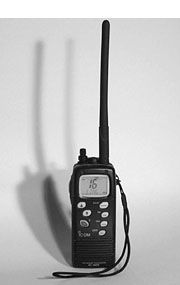Handheld VHF radios appear to be one of the few areas in the marine electronics market that shows continuous change and improvement. Most models are now waterproof or at least represented as such. The size of these radios continues to decrease, and most recently battery capacity has increased markedly. Compared to radios tested several years ago, the current models perform much more like high-end commercial products and not low-priced consumer items. The only disconcerting development? Two manufacturers are representing radios as “waterproof” or “submersible” when, according to our tests, they’re not.

We made the rounds through the various boating catalogs and marine websites and identified 13 models from six manufacturers: Standard Horizon, Uniden, Simrad, Raymarine, Icom and Shakespeare. (Humminbird is out of the handheld radio business.)
Testing Procedure
We bench-tested each radio against its published specifications with a top-of-the-line IFR COM-120B communications service monitor. Our findings are translated into numerical ratings according to the following formula:
For measurable specifications, e.g. transmitter power, receiver sensitivity, the rating are as follows:
4—Meets or exceeds rated specifications. This specifications themselves are among the best in the field of products compared.
3—Meets published specifications but is not among the best tested.
2—Meets published specifications but these specifications are not what we consider on par with other products.
1—Does not meet published specifications or displays a significant flaw.
For subjective, non-quantifiable items, such as ergonomics or display, the ratings are:
4—Among the best now available in the marketplace.
3—Above average.
2—Average in this category.
1—Below average or unacceptable.
As you can see from our chart, this approach gives a very straightforward indication of a model’s strengths and weaknesses. Also listed in our chart are features that we consider important for this product category. In the case of VHF handhelds these include:
12 VDC Charger: Some manufacturers include a DC charger with their radios; others require you to purchase one. Given that DC power is the standard on board, we consider the inclusion or availability of a 12-volt charger important.
AA Battery Pack: AA battery packs provide the availability of instant power. Alkaline batteries can be stored for long periods and provide the maximum operational capacity.
Rapid Charger: All types of rechargeable batteries normally take longer to charge than to discharge. A rapid charger will recharge a handheld in 1 to 3 hours versus up to 16 hours for a regular charger.
Battery Type: Until recently, NiCad (Nickel Cadmium) batteries were the standard in rechargeables. Now NiMH (Nickel Metal Hydride) batteries, and most recently LiIon (Lithium Ion) batteries offer increased capacity, decreased size, freedom from memory effects, and an increased number of charge/discharge cycles.
Battery Capacity: The higher this number, the more hours you can run your radio between charges. Note that some models offer more than double the capacity of others.
Antenna Connector: In an emergency, the ability to connect your handheld to your fixed antenna could save your life—especially in a sailboat with a mast-mounted antenna, which would greatly extend the handheld’s range. While most of us have never heard of an SMA connector, knowing that it’s standard and that an adaptor is available is very important.
Finally, we believe a waterproof device should be usable in the rain—without a plastic cover. It should also survive immersion in shallow water—such as in a bucket, puddle or bilge—without damage. Each radio was briefly immersed in a bucket of clean water. It was tested immediately and then retested the next day.
Standard Horizon HX460S
The HX460S is Standard’s latest introduction since Vertex Standard purchased the Marine Division of Standard Communications. Vertex has long been known for its ability to produce miniature radios. The HX460S follows in this tradition. It’s slightly wider and thicker than a pack of cigarettes and includes a high-capacity LiIon battery and a rapid- rate wall charger. Operation is via volume and squelch controls and eight front-mounted pushbuttons. A lamp switch for its large backlit display is located below its push-to-talk switch. A removable, swivel-action belt clip is included. It’s available in black and titanium color schemes.
Pros: small size, included rapid charger, excellent transmitter performance, submersible, high battery capacity. Cons: antenna could be shorter, slightly buzzy audio at high volume, belt clip easily lost.
Bottom line: The Standard Horizon HX460S is a superb performer, waterproof and very compact. We recommend it.

Standard Horizon HX350S
The HX350S is a full-featured, fully submersible handheld. It’s supplied with both a 12 VDC and AC charger. A NiCad battery and an AA battery tray are included, too. Its large display is extremely visible.
Volume and squelch knobs are top-mounted. Seven front-mounted pushbuttons control other functions. Another small pushbutton below its push-to-talk switch serves as a high/low power control.
The HX350S tested very well. Transmitter and receiver performance were above average. A small amount of water was found in its battery compartment after submersion but its functioning was unaffected.
Pros: excellent performance, waterproof, comes complete with most common accessories. Cons: none.
Bottom Line: The Standard HX350S is an excellent all-purpose radio at a very fair price, including a 12-volt charger and good battery capacity. We give it our Best Buy recommendation.
Standard Horizon HX260S
The HX260S, Standard’s entry-level waterproof VHF handheld, features an easily readable large display. A volume control is top-mounted. Seven front-mounted and three side-mounted pushbuttons allow you to control other functions. Squelch level is adjusted by pushing one of the side-mounted buttons and then the up/down arrow keys. A NiCad battery pack, AA battery holder, and wall-pack charger are included.
The HX260S tested very well. Transmitter and receiver performance were both above average. Some water was found under its battery after submersion, but the radio remained operational.
Pros: Waterproof, well-made, excellent performance. Cons: Wall-pack charger.
Bottom Line: The Standard Horizon HX260S is a superb entry-level handheld. The additional $50 you pay in comparison to the least expensive models tested is well worth it, in our opinion.
Simrad HT50
Simrad’s HT50 is a mid-sized, full-feature, 5-watt VHF handheld. It’s supplied with a wall-mounted slide-in charger and Nickel Metal Hydride (NiMH) battery. The HT50 performed very well during testing. Its receiver and transmitter performance is on a par with the best of the radios tested. Its receive audio was loud but slightly tinny. Its display is large and easy to read. Our only complaint is what we view as slightly quirky operation. The HT50 reverts to channel 16 whenever switched on. This could be problematic if you assume that the radio will remain on the last channel used. Additionally, the weather channels must be accessed by scrolling through to the end of the other channels. There is no way to directly access the weather without multiple keystrokes.
Pros: Superb transmitter and receiver performance, loud receive audio. Cons: Quirky operation, charger cannot be placed on a desktop without laying it down.
Bottom Line: The Simrad HT50 is very well made, fairly priced and performed very well. It’s not our top choice, but a good buy.
Uniden HH985
The Uniden HH985 is a full-sized waterproof VHF handheld. It’s packaged with a NiCad rechargeable battery pack, AA battery holder, and drop-in standard rate charger. Its large display is angled slightly upward to enhance visibility.
Volume and squelch controls are mounted on the top. Eight front-mounted pushbuttons control all other functions. The HH985 performed well. However, its receiver specifications were far from superior. A weather alert decoder feature is also included.
Pros: Large tilted display, weather alert. Cons: Big and bulky by current standards, less than stellar specified capabilities.
Bottom Line: The Uniden HH985 performed adequately, according to its stated specs. It did test to be watertight as advertised; however, the design seems antiquated to us.
Uniden HH940P
The Uniden HH940P is designed as a sub-compact, fully waterproof VHF handheld intended primarily for the personal watercraft market. The lightweight, small design makes it ideal for clipping to a swimsuit. It’s supplied with a drop-in charger and NiCad battery.
A small but very readable display is on the top and slanted. Seven front-mounted pushbuttons and a channel up/down rocker switch control all functions. During testing, transmitter and receiver performance were acceptable. The radio was fully submersible, as advertised.
Pros: compact, watertight, low price. Cons: low transmit power, low battery capacity.
Bottom Line: The HH940P’s low price and small size make it ideal for its intended use. Other radios in this price range are simply bigger and heavier. If you plan on cavorting on the water in easy range of the mother ship, take along one of these.
Uniden Atlantis
The Uniden Atlantis is an entry-level VHF handheld. It’s supplied with an NiMH battery and DC charging cord. No AC charger is supplied. It has a large, front-mounted display, concentric volume and squelch controls and eight front-mounted pushbuttons. It’s sold and labeled as waterproof. The Atlantis performed marginally during testing. Transmitter performance was acceptable but its receiver was overly sensitive to interfering signals. Most importantly, it flooded immediately when submerged.
Pros: low price and high-capacity battery. Cons: not waterproof, mediocre performance, charges very slowly.
Bottom Line: If Uniden did not list this model as waterproof we would consider recommending it as an entry-level radio.
Raymarine Ray100
The Ray100, Raymarine’s entry-level handheld radio, is supplied with a NiCad battery, AA battery holder and drop-in charger. Its front-mounted display is good but could be larger. Six pushbuttons and top-mounted volume and squelch knobs control all functions.
The Ray100 performed well and kept working after submersion.
Pros: waterproof, good performance. Cons: Slightly tinny audio, battery not fully encased, low battery capacity.
Bottom Line: The Raymarine Ray100 is an adequate but otherwise unremarkable radio. It performed well but is not our first choice in its price class.
Raymarine Ray102
Raymarine’s Ray102 is slightly more expensive and has a larger display than the 100. However, the radio itself is smaller than the Ray100.
Volume and squelch controls are on the top of the unit. Five pushbuttons and an up/down rocker switch control other functions. Receive audio was crisp but could be louder. A desktop, wall-mountable charger is included. Receiver and transmitter performance were very good.
Pros: Excellent performance, well made, waterproof. Cons: low-capacity battery.
Bottom Line: The Raymarine Ray102 is a good all-around radio. We can recommend it without reservation.
Icom IC-M2A
The IC-M2A is Icom’s least expensive submersible VHF handheld. Its most prominent feature is its very large display. Controls include a top-mounted volume knob and eight front-mounted pushbuttons. A drop-in charger and 750 mAH NiCad battery and AA battery pack are supplied. We were impressed with the IC-M2A’s superb performance during testing. Both transmitter and receiver parameters tested well above average. Our only quibble was that we needed to shake the radio hard after submerging it to clear the water from its speaker.
Pros: Large display, excellent performance, waterproof. Cons: relatively low-battery capacity.
Bottom Line: The Icom IC-M2A is a very well made and a fairly priced radio. It also performed excellently. We highly recommend it.
Icom IC-M3A
The Icom IC-M3A is the company’s current low-priced entry-level model. It’s supplied with a AA battery tray filled with NiCad rechargeable cells. This approach helps cut costs while still including the ability to operate the radio from either alkaline or rechargeable batteries. A wall-pack charger is supplied. It has a top-mounted volume control and eight front-mounted pushbuttons.
This model is not waterproof nor does Icom represent it as such. Its excellent transmitter and receiver performance were remarkable for a radio in this price range.
Pros: excellent performance, low price. Cons: not waterproof.
Bottom Line: The Icom IC-M3A is a great entry-level VHF handheld. We recommend it highly as our top low-priced radio.

Icom IC-M1V
The Icom IC-M1V is the company’s current high-end handheld. It’s compact, full of features, submersible and performed exceptionally well. Our only criticism is its relatively long antenna. We would rather see a shorter antenna on such a compact radio. Icom supplies a drop-in charger and 1600 mAH Li-Ion battery with the M1V. This battery should easily last through a long summer day, especially when transmitting on low power. We especially liked this model’s very ergonomic, hand-friendly design. The simple curves of its case increase how comfortably it fits in your hand. During testing, it performed exceptionally well. Transmitter and receiver performance were on a par with high-end commercial radios that we’ve seen.
Pros: Superb performance, high-capacity battery, ergonomic design. Cons: Long antenna.
Bottom Line: The Icom IC-M1V is a great radio. It is our top pick in the VHF handheld category based on its performance alone—but we think its higher cost is justified.
Shakespeare SE700
The Shakespeare SE700, the company’s only VHF handheld offering, is supplied with a high-capacity NiMH battery, charger and DC charging cord. Its charger is a rapid rate ACwall pack with a cigarette lighter socket on its front. This approach (cost-effectively) allows Shakespeare to supply both a DC and AC charger. The SE700 has a large front-mounted display. Volume and squelch knobs are on the top. Six front-mounted pushbuttons control all other functions. The SE700 performed adequately. It’s labeled as having a 3-year “watertight warranty.” In our opinion, this statement may lead consumers to believe that the radio is watertight. Unfortunately, this was not the case in our tests. The SE700 flooded immediately and was permanently damaged as soon as it hit the water.
Pros: high-capacity battery, unique charging system. Cons: tested unit not watertight as advertised.
Bottom Line: The Shakespeare SE700 we tested did not perform well. As a result, we can’t recommend it.
Conclusion
Many of the models tested in this round performed very well. Icom and Standard Horizon remain at the top of the pack. Their radios are all well made and very competitive in both performance and price. Raymarine has also continued to produce a good radio.
Also With This Article
Click here to view “Performance: Handheld VHF Radios.”
Click here to view “Specs: Handheld VHF Radios.”
Contacts— Icom, 2380-116th Ave., NE Bellevue, WA 98004; 425/454-8155; www.icomamerica.com. Raymarine, 22 Cotton Road, Unit H, Nashua, NH 03063; 603/881-5200; www.raymarine.com. Shakespeare, 19845 Highway 76, PO Box 733, Newberry, SC 29108; 803/276-5504; www.shakespeare-ce.com/. Uniden, 4700 Amon Carter Blvd., Ft. Worth, TX 76155; 800/586-0409; www.uniden.com. Standard Horizon, 17210 Edwards Rd., Cerritos, CA 90703; 562/404-2700; www.standardhorizon.com. Simrad, 1500 NW 1st St., Suite 1-E, Dania, FL 33004; 954/922-7700; www.simrad.com.
































